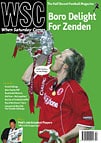 Football’s history remains largely untouched by the marketeers – but FIFA are determined to do something about that. Barney Ronay ponders Pelé’s official hot 100 selection
Football’s history remains largely untouched by the marketeers – but FIFA are determined to do something about that. Barney Ronay ponders Pelé’s official hot 100 selection
History is written by the winners. Pelé, twice a World Cup winner and the highest-earning 20-years-retired sportsman on the planet, is in the process of taking this process to a ludicrous extreme. As part of FIFA’s centennial celebrations the great man has been commissioned to draw up – possibly in biro on the back of an envelope – the “FIFA 100” list of the greatest living players, due to be unveiled this month after a mildly snowballing web-centred publicity campaign. As FIFA-run website The-100.com explains: “For the 100 years of FIFA, Pelé has chosen a living footballer that represents the best, most outstanding, creative, players of their generation.”
For a month leading up to his chart rundown, Pelé has teased us with a selection of names. Thierry Henry has made the cut, as has Roy Keane; the stately Karl-Heinz Rummenigge will be punching the air in the style of a reprieved Big Brother contestant, as will Roberto Baggio and Mia Hamm of the US women’s team. The remaining 94 living legends are set to be revealed at a celebratory banquet hosted by the list-master in London on March 4. (“During the evening Duran Duran will perform,” warn the organisers.)
Why is this happening? The hot 100 website provides some clues. “The selected players have been shot,” it begins, slightly misleadingly, “by the world’s leading photographers.” As with all such industry lists, there is something for sale here: signed portraits by “the world’s leading photographers, including William Klein, Patrick Lichfield… and Helena Christensen”; a range of FIFA 100 merchandise; and a book with a forward by the omnipresent Pelé, in which “the very essence of athletic greatness is depicted”. The past is football’s last remaining virgin territory; uncolonised land as far as the game’s marketeers are concerned. The FIFA 100 is the most concerted attempt yet to carve it up into saleable plots. And with Pelé as our plantation boss we’re about to find out exactly where Emilio Butragueño, Roger Milla and Ian Rush stand in the larger scheme of things.
The FIFA 100 is a viral marketing exercise, perfectly tailored to the potent Chinese whispering of the internet. The build-up to the unveiling – in fact the very notion of a list – plus the opportunity to debate in pointless detail the merits of a mismatched roster of legends are familiar tenets of the rambling, gossipy hothouse of football on the web. The FIFA 100 may have started out as a means of celebrating the past, but in execution it has become a way of packaging it up and selling it back to us. Everybody stands to gain: FIFA get to sell things; Pelé reinforces his status as brand leader; and, like contestants on I’m a Celebrity… Get Me Out Of Here!, 99 living football legends will begin to attract unexpected and apparently tangential financial rewards simply by virtue of their inclusion. In time FIFA will be able to afford another small island in the south Pacific and Pelé himself will be able to continue travelling by helicopter to grands prix in the company of catwalk models, while wearing solid gold shoes and a diamond-encrusted cravat.
The pre-list shoo-in for number one, Pelé is key to the success of the whole exercise. Pelé is the Citizen Kane of football, its Sergeant Pepper’s Lonely Hearts Club Band, its Fawlty Towers, inked in at the top of every poll of the best players in the world… ever! In fact, Pelé’s post-playing career is a definitive template for the marketing of on-field success. In recent times Pelé has advertised cars, soft drinks, sweets, credit cards and chemical aphrodisiacs. He earns at least $20 million (£11m) a year from deals with Coca-Cola, Pfizer and Mastercard, on whose behalf he has made 150 public appearances in 12 years (more than one a month). His face is on two million credit cards. “Pelé is a unique individual who transcends borders,” Mastercard declare, possibly referring to more than just his ownership of a valid passport. By happy chance even his name sounds like one of those meaningless phonemes concocted by focus groups for Japanese cars – words such as Corolla and Corona and Celica – designed to be pronounceable in every conceivable target market.
At best Pelé’s list might be a way for great players of previous generations to slice off a little of the revenue pie currently being doled out to such as Seth Johnson, Ken Bates and Bernie Mandic. At its worst the list is just another FIFA tentacle stretched across the global market. The presence of Keane is something of a giveaway. Keane may be a fine player, but in this context he’s simply a representative of Manchester United, a sop to the shirt-devouring hordes of the Far East.
In spite of which, the celebratory bash promises to be a night of high tension. Will Diego Maradona, for many the greatest recent player but a personal enemy of His Peléness, even make the list? Will FIFA fudge the issue by giving them separate awards, as it did at its millennial dinner? Is Fernando Hierro better than Peter Shilton? Will there be arguments, snubs, fist fights? Will Kevin Keegan, Pelé and Terry Venables sing an a capella version of You’ll Never Walk Alone? Will anyone actually be paying any attention? And how much of the £900 you inexplicably spent on that signed print of Pelé will you be able to claw back by flogging the bloody thing on Ebay?
From WSC 206 April 2004. What was happening this month